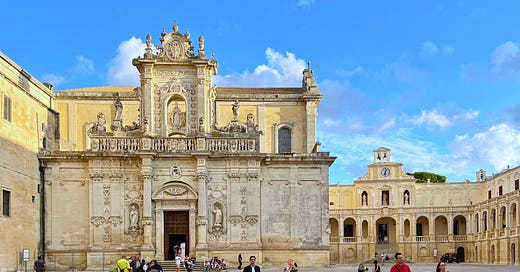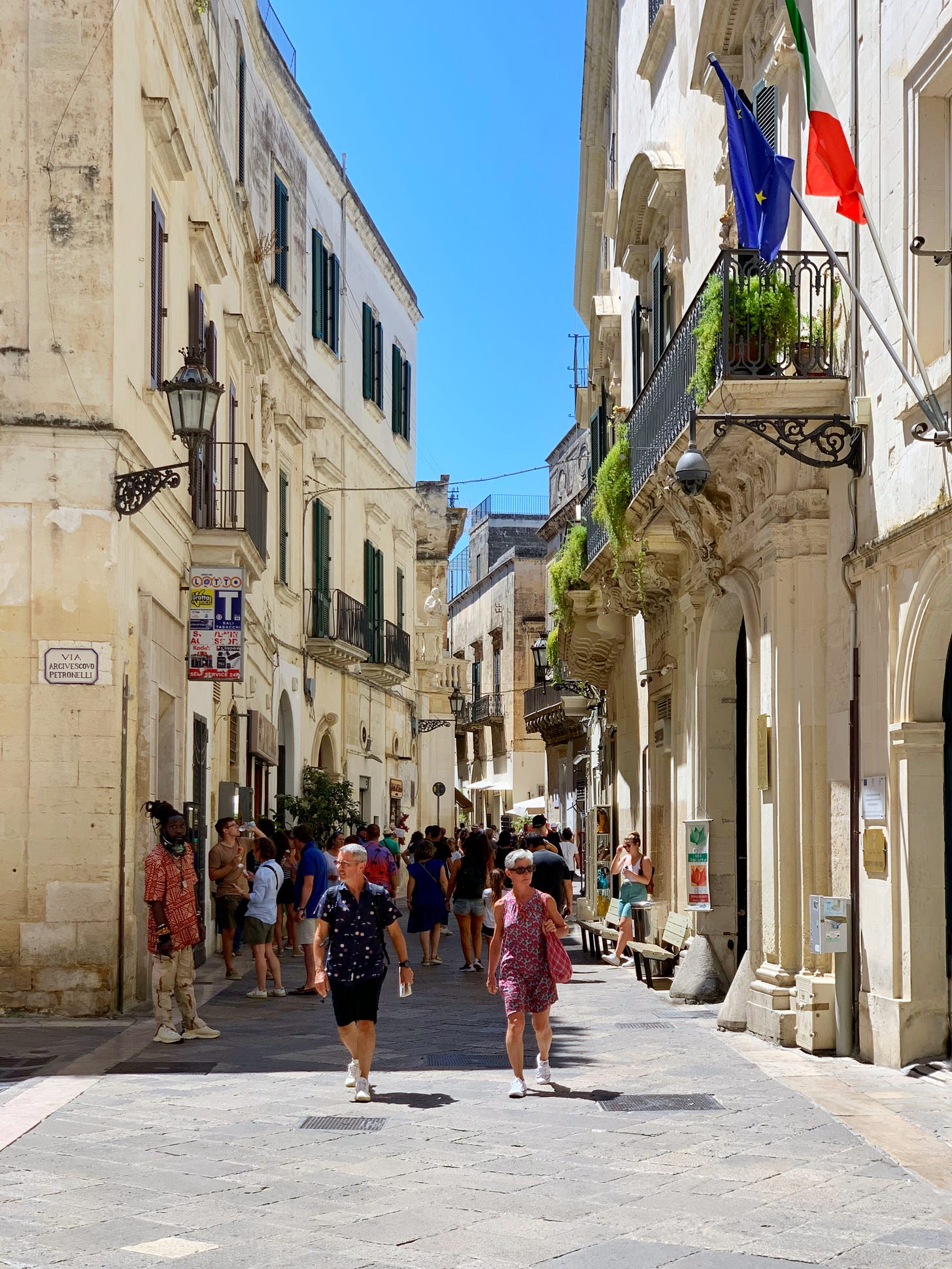Welcome to the New Roman Times’ 72 Hours series! Why 72 hours? Because the New York Times publishes a “36 Hours” series, but in my opinion, 36 hours isn’t nearly enough time to spend in Italy’s greatest cities and most compelling regions. From time to time, I’ll spotlight popular destinations like Rome, Milan, Florence, Venice, the Amalfi Coast and Capri for paid subscribers. Have a place you’d like a 72 hours guide to? Email newromantimes@substack.com or leave a comment here!
Sometimes called “the Florence of the South,” because of its elegant architecture, Lecce has a charm all its own. Though it’s not the capital of Puglia (that’s Bari), Lecce is the largest and most important city in Salento, the southern part of the region. Over the course of its long history, Lecce was ruled by the Romans, Byzantines, Normans, and Aragonese before joining the unified Kingdom of Italy. The Greeks, too, colonized much of the Salento Peninsula and left their mark. But it was a movement called Barocco Leccese that had the largest impact on the city’s appearance.
I first visited Lecce in 2019, on my inaugural trip to Puglia, and have returned a few times since then, most recently last September. Every time I go, I fall in love with the city and the surrounding region a bit more. It’s beautiful, it’s laid-back, and what it lacks in bucket list sights it makes up for with its relaxed approach to life and welcoming southern hospitality.
If you’re trying to plan a trip to Puglia, Lecce makes a great base. Its centro storico is packed with beautiful baroque churches and palaces, plus there are plenty of great restaurants, bars, and cafés, as well as nice boutiques selling handcrafts and clothes. It’s also very close to some fantastic beaches. You can reach the Adriatic coast in about 20 minutes and the Ionian coast in about 40 minutes, so you’re spoiled for choice.
Within 72 hours, you can explore the centro storico, spend some time relaxing on the nearby beaches, and perhaps venture a bit farther to visit a winery or textile atelier. Here’s how to spend three days in Lecce.
DAY ONE
Arrive and get your bearings while easing into Puglia’s slower pace.
3 p.m. - Arrive and check into your hotel
The closest major airport to Lecce is in Brindisi, but if you’re coming from elsewhere in Italy, you’ll likely arrive by train or car. If you want to stay right in the center of town, book a room at Patria Palace, which just became a member of the Leading Hotels of the World and has a great rooftop restaurant and bar with views of the Basilica di Santa Croce.
Another good option—particularly for art and design obsessives—is Palazzo Luce, an independent boutique hotel with a blue chip collection of art and furniture by the likes of Gio Ponti, Ettore Sottsass, Carlo Mollino, and Marina Abromovic.
4 p.m. - Explore the centro storico
Lecce’s centro storico has the most enchanting golden hue thanks to the honey-colored local limestone used to construct its buildings. Start by visiting the Duomo (its full name is the Cattedrale di Maria Santissima Assunta e Sant’Oronzo), which has an elaborately decorated façade and stands on a huge piazza flanked by the bishop’s palace and the seminary. For a bird’s eye view of the city, buy a ticket to ascend the bell tower and you can take an elevator up to the top. You can also admire examples of barocco leccese architecture at the Chiesa di Santa Chiara and the Basilica di Santa Croce.
The maze of streets radiating out from the Duomo are lined with shops selling summer clothes, ceramics, leather bags, and more. For a unique souvenir, you might want to buy one of the artisan perfumes at Salentum, which makes fragrances using local fruits and flowers like jasmine, orange blossoms, and citrus.
Whether you’re trying to or not, you’ll no doubt wander over to Piazza Sant’Oronzo, the enormous piazza named for Lecce’s patron saint. There’s a statue of him atop a column just in front of the ruins of the Roman amphitheater. In the summer, kids play soccer on the piazza and families flock here for their evening stroll.
If you want a pick-me-up, pop into Caffè Alvino for a caffè leccese (espresso poured over ice and sweetened with almond syrup) and a pasticciotto (a shortcrust pastry filled with vanilla custard and perhaps cherries). Or head around the corner to Natale, which makes delicious gelato as well as pasticiotti.
Keep reading with a 7-day free trial
Subscribe to The New Roman Times to keep reading this post and get 7 days of free access to the full post archives.






